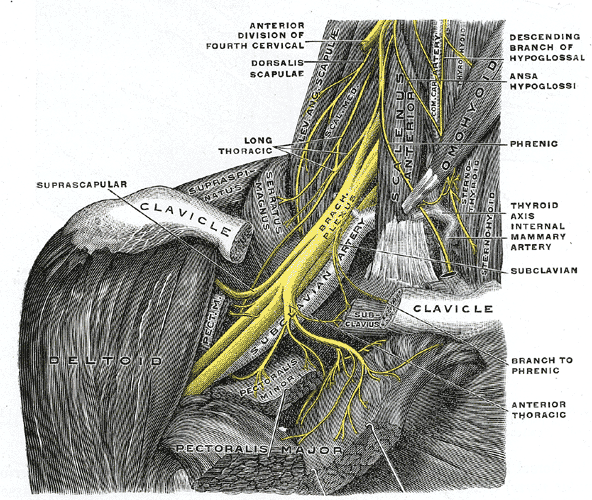
Thoracic Outlet Syndrome
What is Thoracic Outlet Syndrome?
Thoracic outlet syndrome refers to a condition whereby blood vessels and/or nerves that pass into the arms from the neck are compressed, due to narrowing of the thoracic outlet which is the space between the collarbone (clavicle) and the first rib. This can lead to pain, tingling or numbness along your neck, shoulder, arm and hand.
What Are The Causes?

Often, no specific cause is known. Any condition that results in enlargement or movement of the tissues near the thoracic outlet can narrow the space and cause compression of vessels and/or nerves in the area. Examples include:
Trauma
Traumatic events e.g. car accident causing injury, bony or soft tissue changes to the thoracic area.
Repetitive Activities
E.g. those involving repetitive overhead movements, prolonged typing on a computer, and poor lifting techniques can increase strain on tissues in the neck and shoulder to cause compression of the vascular and neural structures in the thoracic outlet.
Anatomical Defects
E.g. extra rib from the neck at brith (cervical rib) narrowing the thoracic outlet and increasing the susceptibility of compression.
Poor Posture
Slouching and drooping shoulders or forward head position can cause increased tension in the side neck muscles and stretching of the nerves, leading to compression in the thoracic outlet.
Muscle Enlargement
E.g. increased muscle bulk at the neck and shoulders from weight lifting can increase susceptibility to compression of the thoracic outlet.
Weight gain. Increased amounts of fat and connective tissue in the neck can increase susceptibility of compression as well.
Tumors at the top of the lung can impinge and compress on the blood vessels and nerves nearby.
What Are The Signs And Symptoms Of Thoracic Outlet Syndrome?
Thoracic outlet syndrome has varying extent of signs and symptoms and can generally be classified into 2 main types based on the strutures involved.
| Neurogenic/ Neurological Thoracic Outlet Syndrome | Vascular Thoracic Outlet Syndrome |
| Nerves in the thoracic outlet are compressed; this is the most common cause of the syndrome | Veins and/ or artieries in the thoracic outlet are compressed |
|
|
What Are The Treatment Options For Thoracic Outlet Syndrome?
Conservative management may be effective especially when the condition is diagnosed early. It includes the following:
- Physiotherapy where a variety of exercises are given to improve the strength and range of movement of the neck and shoulder muscles and joints. These help to open the thoracic outlet and relieve pressure off the compressed blood vessels and/ or nerves. Posture correction and education on self-management are important as well to promote restoration of function.
- Pain medications, muscle relaxants and anti-inflammatory drugs may be given to help reduce inflammation and encourage muscle relaxation.
- Relaxation techniques e.g. breathing exercises may help to reduce tenison in the neck and shoulder muscles and facilitate good posture.
If symptoms are severe, persistent or worsening or conservative management has failed, surgical intervention involving removal of the first rib may ne required to open the thoracic outlet. Following that, rehabilitation is needed to strengthen the muscles and restore function.
Are There Any Preventive Measures For Thoracic Outlet Syndrome?
Thoracic outlet syndrome may not be preventable in some cases due to inherited anatomical defects and other conditions. However, risks for the development and deterioration of the syndrome can be reduced by:
- Avoiding repetitive or prolonged activities with arms held out or overhead, e.g. overhead stocking of shelves, sleeping with arm above the head.
- Avoiding prolonged typing at the computer; have frequent rest periods.
- Avoiding repetitive carrying of heavy objects; adopt good lifting techniques.
- Improving posture; ensure good ergonomics and correct posture at the neck and shoulders.
- Reducing weight if obese.
These measures help to prevent increased strain and tension on the muscles and connective tissues in the neck and shoulders, hence reducing the susceptibility and degree of compression of blood vessels and nerves in the thoracic outlet. -TSH
References
- Mayo Clinic. (2008, Nov 8). Diseases and conditions: thoracic outlet syndrome. Retrieved Nov 24, 2008, from www.mayoclinic.com/health/thoracic-outlet-syndrome/DS00800
- MedicineNet. (2008, Feb 20). Thoracic outlet syndrome (TOS). Retrieved Nov 24, 2008
- Novak C.B. (2003). Thoracic outlet syndrome. Clinics in Plastic Surgery. 30: 175– 188.
- The National Pain Foundation. (2008, Mar 27). My Treatment: thoracic outlet syndrome. Retrieved Nov 23, 2008
Related Articles
- AC joint dysfunction: Another source for shoulder pain Rotator cuff tears, frozen shoulder and impingement are all very common and well-known conditions that may produce dysfunction at the…
- How do I choose Heat or Ice Therapy To Use For… When should you use heat or ice therapy? The answer is - it depends. In general, heat therapy is…
- Missed Upper Thoracic Syndrome Musculoskeletal problems that stem from the upper thoracic spine are often missed or misdiagnosed as cervical in nature by both…
- Repetitive Strain Injuries - Are You A Victim Of It? Repetitive Strain Injuries is really a blanket name for health problems that result from over-use or misuse of muscles, tendons,…
- Triathlon Injuries - 3 Common Injuries &… Triathlon season is upon us again with many races in Singapore between March and April. Triathlons are an intense sport…
